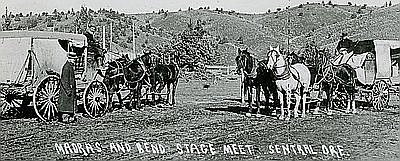Beginning in 1928, the Great Depression caused a downturn in the lumber industry following a collapse of markets for building materials. West of the Cascades, the fir industry was devastated since most fir production was tied to building and construction. On the east slope of the Cascades, pine production diminished, but the demand for furniture, boxes, and other wooden products gave the pine mills customers for their lumber. In Klamath Falls, the Ewauna Box Company operated through the worst years of the Depression with few cutbacks. Their main product was pine boxes for the California fruit growers, and that business continued despite the Depression. The mills in Bend did not fare as well since their products were more closely aligned with construction, but they did keep running and offered at least part-time employment for their veteran workers.
As the Depression deepened in the early 1930s, many mills went bankrupt. Financial firms that provided capital for the industry in the Northwest, like Herbert Fleishacker’s Anglo-California National Bank in San Francisco and the Baker, Fentress and Company in Chicago were also in trouble, unable to extend credit to their clients. In this atmosphere, large mills with extensive land holdings were at a disadvantage since neither the capital nor the revenue that they required for continuing operations was available. Smaller operators flourished. Internal combustion technology in the form of trucks and tractors competed effectively with railroad logging.
The election of Franklin D. Roosevelt and the establishment of the New Deal in 1932 brought two significant programs into the pine country of Central Oregon. The first of these was the National Recovery Administration (NRA) and the Lumber Code Authority. The NRA proposed to regulate prices, wages, and production in the lumber industry through industry associations including the Western Pine Association. Included in the provisions of the Lumber Code was Schedule C, which was a mild conservation proposal aimed at increasing the national forest system, fighting fires and insect depredations, and moving toward a sustained-yield cutting program.
The NRA was disbanded in 1935, but a second New Deal program was to have a much greater influence on forest conservation. This was the Civilian Conservation Corps (CCC), which put 6 million young men to work in the public lands, parks, and Indian reservations throughout the country. It was the largest mobilization of men in the United States prior to World War II. The accomplishments of the CCC included building up the infrastructure of public lands, with new roads, trails, telephone lines, drainage projects, flood control, and administrative buildings all in the mix of improvements. Perhaps more significant than the material accomplishments of the CCC, however, was its ability to inculcate the lessons of conservation and good land husbandry to the enrollees and to the public at large. Unlike some other projects of the New Deal, the CCC was almost universally popular.
To some extent, markets were improving for goods from central Oregon’s pine industry by the mid-1930s. Production statistics for Klamath County show that the volume of pine lumber produced had returned to pre-Depression levels by 1935. Employment data shows that the number of workers in 1935 had come back to pre-Depression levels, but the value of the lumber they produced was only 53 percent of the 1928 cut. The wages the workers earned in 1935 also lagged pre-Depression wages by about 53 percent.
Data show that the central Oregon pine industry was not completely prostrated by the Depression, but that economic life through the mid-1930s was still far below previous levels. In the last few years of the 1930s, the market improved and new lumber mills appeared in several central Oregon locations, including Sisters, Redmond, Prineville, and Gilchrist.
In 1937, six pine mills operated in Sisters, with a daily production of 470,000 board feet. These mills were buying timber from Forest Service sales and the private timber holdings of the S.S. Johnson Company of Redmond. The founder of the Johnson Company, S.O. Johnson, had assembled 40,000 acres of excellent pine during the 1910-1920 period. S.O. Johnson had a colorful career as a northern California lumberman with interests in the McCloud River Lumber Company and the Weed Lumber Company. His son, S.S. Johnson, liquidated the Sisters tract during the late 1930s, selling timber to mills in Sisters and Redmond. Other Redmond pine mills included the Dant and Russell mill, and the Tite Knot Pine Mill.
None of the new mills built in the 1930s employed railroad logging technology. Motor trucks were convenient and reliable by 1938, and far less expensive than railroad equipment. With the trucks came gasoline, and later diesel, tractors to yard the logs to the landings where motor cranes loaded them onto the trucks.
At the outset of World War II, the lumber industry faced challenges from the war itself and from the changing nature of the business. Logging and lumber manufacture were acceptable “war work” but could be carried on only to meet government contracts. In other words, the only buyer of lumber was the federal government. Firms were encouraged to increase production, often overcutting their private land holdings. Labor was scarce, since loggers and lumber workers were not excluded from the draft until later in the war.
One problem that nagged central Oregon logging during the war—at least on a psychological basis—was the Japanese identification of the West Coast forests as a strategic target. On September 9, 1942, a Japanese airplane based on a submarine dropped incendiary bombs on the coastal forest near Bandon, Oregon. The Japanese also sent balloons with incendiary bombs into the upper atmosphere, where the jet stream delivered them to the west coast. In Klamath County, four civilians were killed by a balloon bomb on the Fremont National Forest, earning them the unpleasant distinction of being the only civilian casualties killed on U.S. soil by enemy action.
© Ward Tonsfeldt and Paul G. Claeyssens, 2004. Updated and revised by OHP staff, 2014






